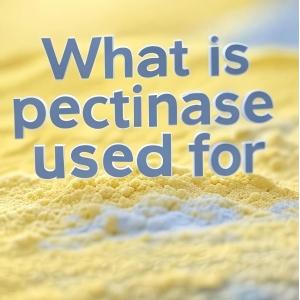Where does pectinase come from

What Is Pectinase?
Pectinase is an enzyme that breaks down pectin, a complex polysaccharide found in the cell walls of plants. It plays a critical role in industries like food processing, winemaking, and textiles by facilitating processes such as juice clarification and fiber extraction. Understanding where pectinase comes from involves exploring its natural sources and the methods used to produce it commercially.
Natural Sources of Pectinase
Pectinase occurs naturally in various organisms, including plants, fungi, bacteria, and some insects. These sources produce the enzyme to break down pectin for different biological purposes, such as aiding digestion or facilitating plant tissue degradation.
Plant-Based Pectinase
In plants, pectinase is naturally present in fruits like apples, citrus fruits, and berries. It helps soften fruit during ripening by breaking down pectin in cell walls, making the fruit softer and juicier. However, plant-derived pectinase is not typically used for industrial purposes due to low yields and challenges in extraction.
Microbial Sources of Pectinase
The majority of commercially available pectinase comes from microorganisms, particularly fungi and bacteria. Fungi such as *Aspergillus niger* and *Rhizopus* species are prolific producers of pectinase due to their ability to secrete large quantities of the enzyme. Bacteria like *Bacillus* and *Erwinia* species also produce pectinase, often used in specific industrial applications. Microbial pectinase is preferred for its high yield, stability, and ease of production.
Industrial Production of Pectinase
Commercial pectinase is primarily produced through microbial fermentation, where selected microorganisms are cultured under controlled conditions to maximize enzyme output. This process ensures a consistent supply of high-quality pectinase for industrial use.
Fermentation Process
The production of pectinase begins with the cultivation of microorganisms like *Aspergillus niger* in a nutrient-rich medium containing carbon sources such as pectin or fruit pomace. The fermentation process can be either submerged (liquid) or solid-state, depending on the desired enzyme characteristics. After fermentation, the enzyme is extracted, purified, and concentrated to meet industry standards.
Purification and Formulation
Once extracted, pectinase undergoes purification to remove impurities and other enzymes. Techniques like centrifugation, filtration, and chromatography are used to achieve high purity. The enzyme is then formulated into liquid or powder forms, depending on its intended application, such as food processing or textile treatment.
Applications of Pectinase
Pectinase derived from microbial sources is widely used across multiple industries. In the food and beverage sector, it aids in juice clarification, increasing yield and clarity in products like apple and orange juice. In winemaking, pectinase helps remove haze-forming pectins, improving wine quality. The textile industry uses pectinase to enhance fiber quality by removing pectin from plant-based materials like flax and hemp. Additionally, pectinase is used in pharmaceuticals to extract bioactive compounds from plants.
Why Microbial Pectinase Dominates
Microbial pectinase is favored in industrial applications due to its scalability, cost-effectiveness, and ability to be tailored for specific needs. Unlike plant-derived pectinase, microbial enzymes can be genetically engineered to enhance activity, stability, or specificity. For example, genetically modified strains of *Aspergillus niger* produce pectinase with optimized pH and temperature ranges, making them suitable for diverse applications.
Environmental and Ethical Considerations
The production of pectinase from microorganisms is generally eco-friendly, as it utilizes renewable resources like agricultural waste (e.g., fruit pomace) as substrates for fermentation. Additionally, microbial pectinase is biodegradable, reducing its environmental impact. Ethical sourcing of microbial strains and adherence to regulatory standards, such as those set by the FDA and WHO, ensure that pectinase production meets safety and sustainability requirements.
Challenges in Pectinase Production
While microbial production is efficient, challenges include maintaining consistent enzyme activity and optimizing fermentation conditions. Variations in microbial strains, substrate quality, or environmental factors can affect enzyme yield. Advances in biotechnology, such as strain improvement and process optimization, are addressing these challenges to meet growing global demand.


